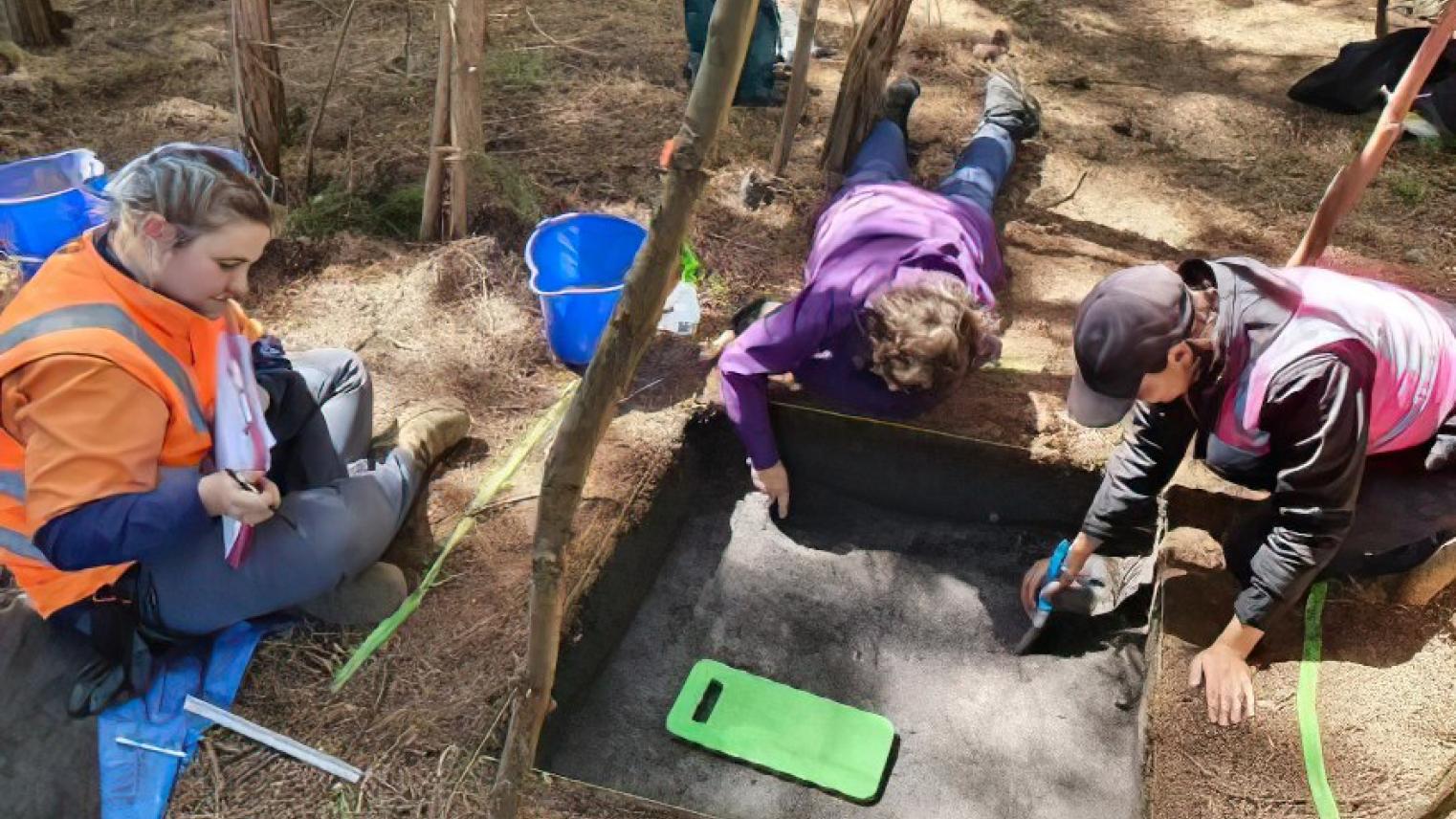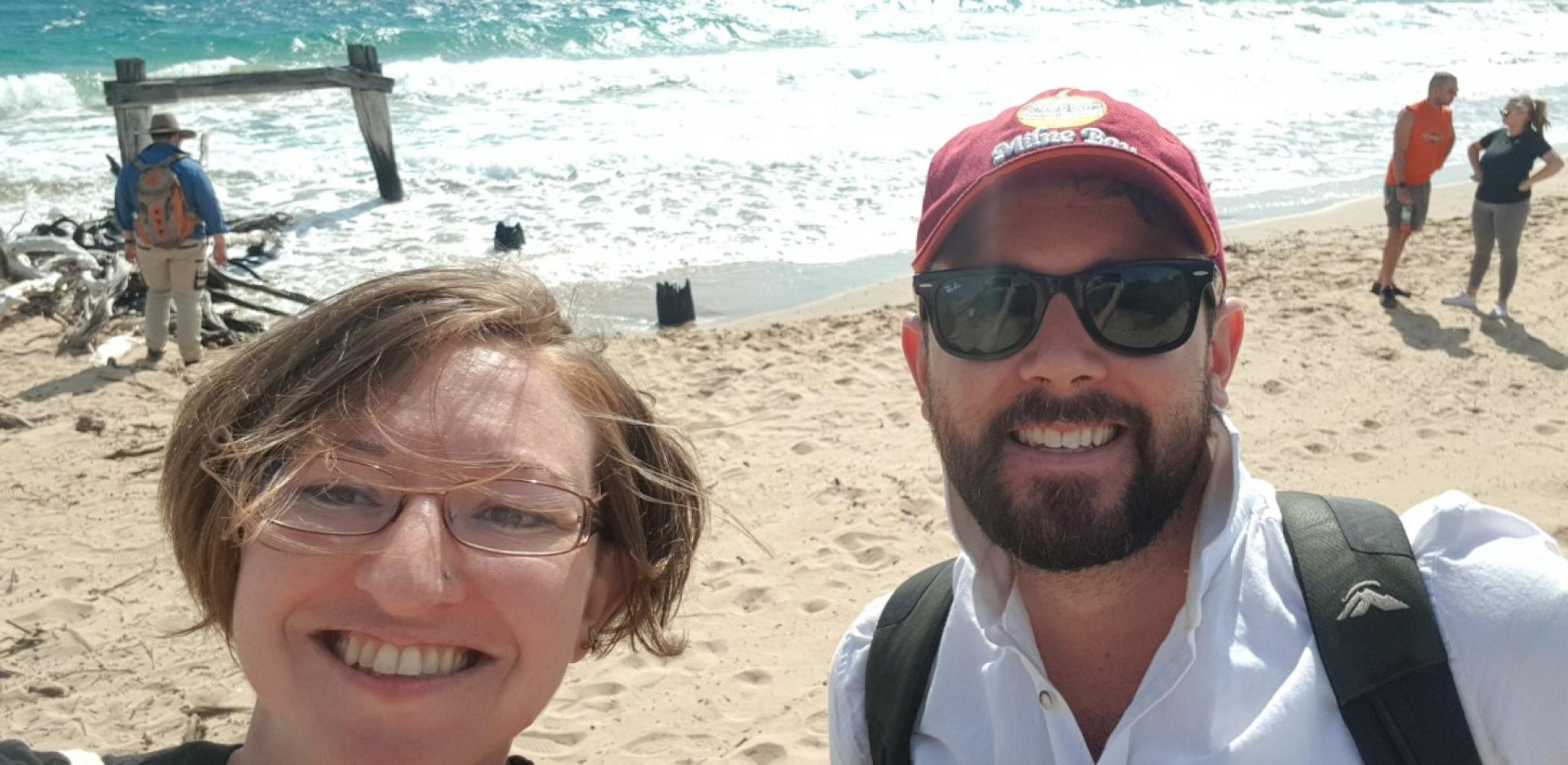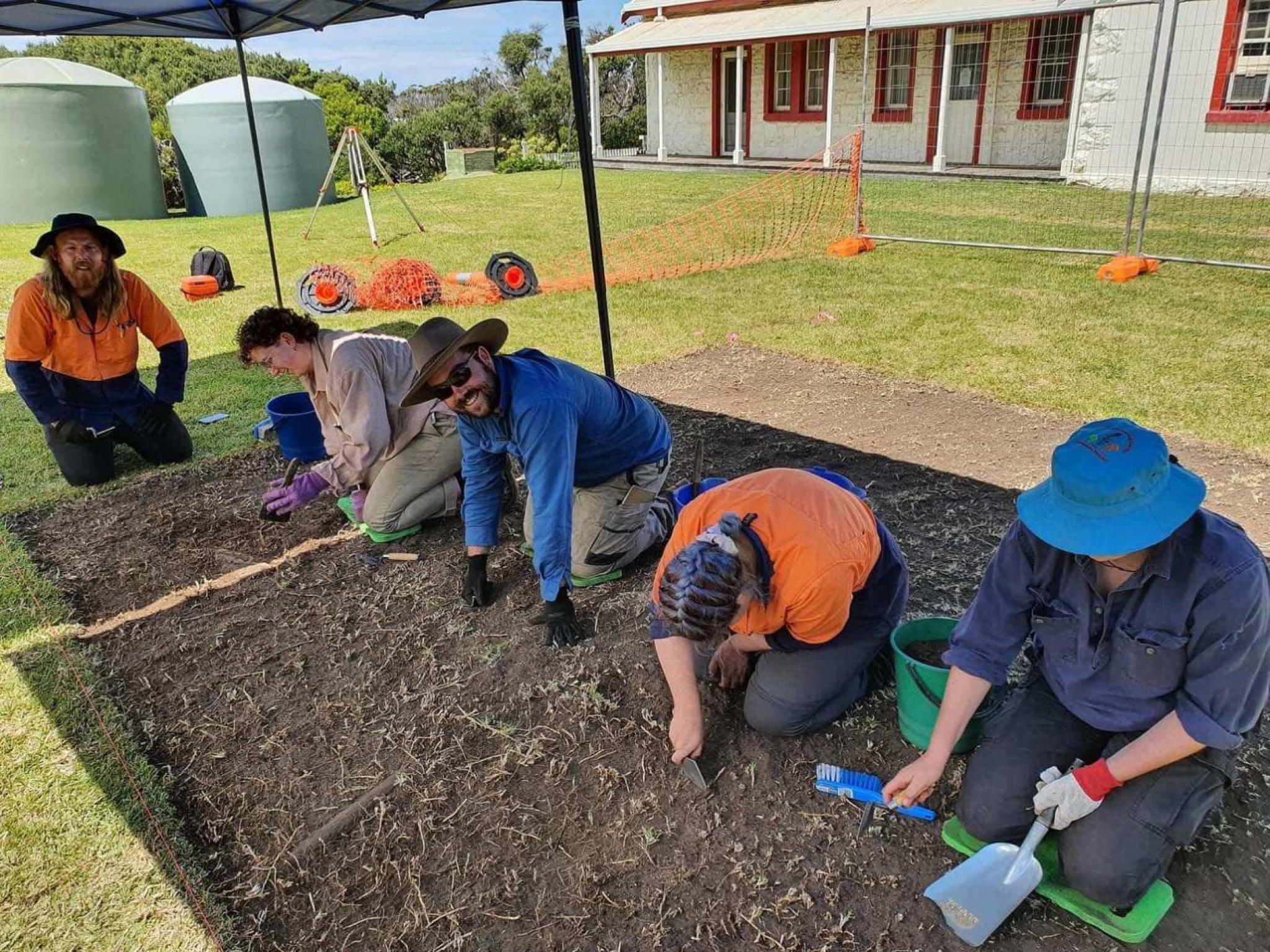ANU Field Schools See the Dawn in Mornington

“I am thrilled that the Mornington Peninsula Field School was such a success. I followed the progress of the students on social media and thoroughly enjoyed getting a window onto the world they were uncovering. Field Schools are vital for equipping our students with the skills they need and for building respectful relationships with the local custodians of the land. The shared knowledge and understanding that results is transformational.”
– CAP Dean, Hellen Sullivan
Pre-2019, life was of course very different; and it was the same for field schools and in-country experiences. They were popular, fun, fantastic learning opportunities, and manageable to plan and execute. But when COVID arrived, naturally they were no longer a possibility. The student experience was limited to a virtual world with no physical, social and onsite connect whatsoever.
Since nothing was likely to change on the international travel front, one team at CHL decided to shake things up a bit. We caught up with Dr Ben Shaw from the Evolution of Cultural Diversity Initiative (ECDI) to hear about this very interesting and amazing journey, wherein he turned a shortcoming into an opportunity—organising the first successful field school since the pandemic. To fill the gap, he decided to organise an onsite archaeology experience within Australia—the Mornington Peninsula Field School.
Congratulations on spearheading a very successful field school and achieving this milestone by breaking the COVID draught in this department! Can you tell us how the idea of the field school originated, and what the journey was like for you from conception to planning?
Thanks very much! The idea for an archaeology field school in Victoria developed in late 2020 when it was apparent that international travel would not be possible for some time. It was originally intended as a temporary stand in for the Papua New Guinea field school. However, I figured that it was going to take just as much time and effort to arrange the logistics so why not make it something special for students who had not had a field school opportunity for the last couple of years.
At this time COVID numbers in NSW were high and the vaccine had yet to be rolled out, so ever-changing border restrictions and lockdowns had to be factored in to field school logistics. It had to be held within Australia and I was keen to hold it in Victoria where the legislation for cultural heritage protection was progressive.
With all these things considered this led me to reach out to my good friend and colleague, Bianca DiFazio, the Director of Heritage Insight, a well-respected archaeological consultancy company based in Melbourne. Bianca and I had talked a lot about the skill sets students need when they enter the professional workforce, and as most students will work in consultancy, lamented that most universities don’t necessarily prepare students for a career in consultancy. We, therefore, set out to create a field school that filled this gap.
Between COVID outbreaks in early 2021, I made a trip down to Melbourne, and with Heritage Insight went to scope out a location for the field school that had enough infrastructure to host 20–40 people for a couple of weeks and was away from dense populations so we could keep everyone COVID safe.
Initially this took us to a sheep station 1.5 hours west of Melbourne to speak to the property owner, and to Eastern Maar—the Aboriginal traditional owners. The shearer’s quarters were perfect to house the students and the land near a creek that meandered through the property was to be the focus of our investigations.
The archaeology looked great and Eastern Maar were supportive, but the farmer had reservations about hosting a two-week field school in spring as the place was often booked out as a wedding venue. The location fell through, and we were back to the drawing board.
Not long after this, Bianca and I met with the Bunurong Land Council Aboriginal Corporation, the organisation that managed the traditional lands of coastal Melbourne and the Mornington Peninsula. After an initial meeting and the hasty preparation of a proposal to be considered at their next board meeting a few days later, Bunurong agreed to partner with ANU and Heritage Insight to run the field school.
Mornington Peninsula was to be the location of the field school, and two locations were considered for investigations. The first, a sand dune landscape at Fingal Bushland Reserve that had likely been used as an Aboriginal camp site for millennia. The second, at Cape Schanck Lighthouse Reserve where a lighthouse and living quarters were established in 1859 on the southernmost tip of the Peninsula to guide ships into a fast-growing Melbourne city. They were perfect, and as they are only 5 minutes’ drive from one another, why not have the students work at both sites concurrently so they get experience working on both Aboriginal and historic European archaeological site contexts.
Between ANU, Heritage Insight and Bunurong we had enough staff to supervise both sites—things were up and running!
Bianca and I didn’t want the field school to just be about digging a hole in the ground. Rather, it was also to introduce the students to the myriad of organisations involved in regulating and managing cultural heritage in Victoria. We met with First Peoples State Relations, Heritage Victoria, Parks Victoria, Mornington Peninsula Shire Council to arrange for their teams to give a talk to the students about their role in cultural heritage, with Heritage Insight hosting a panel with their staff with different levels of experience to offer advice for getting into the industry. The aim of the talks was to highlight that there are many ways of working in the cultural heritage industry and to provide points of contact for students who were about to graduate to find employment or to follow up on their interests.
The Mornington Peninsula is a popular destination for school camps so there were a couple of lodges within half an hour’s drive of our selected archaeological sites. A lodge was booked, the dates of the field school were locked in for September, and a call went out for enrolments. We got more enrolments than we could take on which was hugely positive.
All was looking good. However, Victoria rather than NSW was now the focus of the COVID outbreaks, and the state borders were shut. There was no way the field school was able to be run. It had to be postponed only a month before it was due to start, knowing all the hard work may be lost if momentum was lost and we couldn’t get it running again soon. Coordinating with Heritage Insight, Bunurong, and now the large suite of partners we aimed for February just before the first semester kicked off at ANU and after kids went back to school in Victoria so the field sites—on public land—would not be overrun with holiday makers.
Fast forward to January 2022 and COVID numbers in Victoria were the highest they had ever been, and two weeks before the start of the field school it was uncertain whether it could, or should, go ahead. If it didn’t go ahead now it wouldn’t go ahead at all, but student and public safety was paramount. Plans hinged on getting enough Rapid Antigen Tests to ensure everyone involved in the field school did not have COVID.
With a rigorous COVID plan in place the field school ran in the end without any disruptions, and with all our partner organisations able to contribute as planned. The weather also read the script and it was beautifully sunny and calm for the two weeks. It was a long road of planning and postponements, but in the end the field school exceeded our expectations, and now we are ready to go again for 2023!
Why do you think field schools like this are important, and how does something like this initiative fit into the larger vision or plan for ANU’s strategic mission?
Learning practical skills is absolutely essential for a discipline like archaeology. Even if your intended career path may not involve fieldwork, it is vital to understand how data is collected from cultural heritage sites as it feeds into everything that happens afterward, from curation, interpretation, and mitigation. It also provides firsthand experience working respectfully On Country alongside the Traditional Owners that is important for anyone working anywhere in Australia.
The field school was designed to be collaborative to also provide students an intensive introduction to the legislation that governs cultural heritage management and to the organisations that enforce it.
The field school initiative fits into the ANU strategic vision on a number of key fronts. First and foremost, as cultural heritage practitioners we have an obligation to the Aboriginal communities we work with. One that I take very seriously, and one that aligns with a key value of ANU to engage respectfully and sustainably with First Nations Peoples. To recognise the contribution and essential role that traditional owners have in imparting knowledge to students on the field school I obtained ANU-sponsored placements, so the Traditional Owners who were involved get full course credit for completion. Each year, different representatives from Bunurong will be enrolled in the field school, with the credit able to be cross credited to a number of tertiary education programs.
What were the main challenges with the field school?
There were many! So, it turns out that setting up a collaborative field school of this scope during a global pandemic is a bit of a challenge—no surprises there! But, at the same time the initiative developed because of the pandemic, so I was happy to put in the effort to get it going. The main challenge was, of course, COVID. The field school had a lot of moving parts and with lots of people now involved, it required face-to-face trips to Melbourne and the Mornington Peninsula to arrange.
However, these in-person trips were cancelled on three occasions due to outbreaks and lockdowns! During these tough times, I feel so fortunate to work with such a dedicated team as Heritage Insight. Once the February dates for the field school were locked in, the major issue was getting a hold of enough Rapid Antigen Tests in time to run the field school safely—at a time when stock was virtually non-existent.
I placed an order for a large batch of tests through a reputable supplier in early January. The tests arrived in Australia on time together with the supplier’s order of 40,000, but much to our surprise they were held by customs without explanation or a release date.
Eventually, I learnt that the shipment had been re-directed elsewhere and private orders would not be fulfilled. I’ll give you three guesses who commandeered the supply, but you probably only need one! Having been told that my order would probably not arrive on time I spent several days trying to scrape together enough from supermarkets, pharmacies, and other stores to make do - with a healthy dose of time pressure and stress to go with it! I got hold enough to test all the students on the first day so we could establish our ‘covid bubble’, and the supplier eventually sent some in the nick of time to bolster supplies. We were off and running!
What, according to you, were the highlights of the experience?
By far the best experience was seeing the students develop during the two short weeks we were away. Most had no experience working on an archaeological site, and day to day conditions could be rough, especially at Cape Schanck which is exposed to the strong Bass Strait winds, so seeing everyone looking out for each other always put a smile on my face.
With the diverse range of speakers and partners involved all the students connected in some way to the content, and some have already been offered employment through partner organisations once they finish their studies! The field school was open to both postgraduate and undergraduate students and was not restricted to those doing archaeology degrees. As a result, we had a good mix of students from study backgrounds that connected in way to cultural heritage and Indigenous engagement.
What are your future plans with respect to research and fieldwork?
The plan is to now run the Mornington Peninsula field school each year in February and to increase the annual student intake slightly to cater for the interest. The feedback from our partner organisations has been overwhelmingly positive, with other industry partners likely to come on board next year to expand the teaching and outreach capacity.
The two weeks of fieldwork resulted in a surprisingly large assemblage of stone artefacts and historic materials being excavated. The data will contribute significantly to regional, national, and potentially global models of past human landscape use. The students should be proud of the work they have done, with many having the opportunity to continue working on the assemblages.
For the students doing a Masters in Archaeological and Evolutionary Science they are able to undertake a 6-credit research project that can involve analysing and interpreting some of the cultural material they excavated.
Anything else you’d like to add?
Just to say a huge thank you to Heritage Insight and to the Bunurong Land Council for their support and trust. The field school would simply not have come to fruition without the unwavering support of both who invested a great deal of in-kind capital and did so as they are also committed to ensuring the next generation of archaeologists and cultural heritage practitioners are well trained and ethically driven when it comes to working On Country.
It’s an honour for us to work on Bunurong Country, and we look forward to continuing to work together on the field school.
For more on the Mornington Peninsula Field School, check out the field school diary here. We look forward to more such landmark field schools and amazing student experiences at CHL, CAP and across ANU this year and beyond.


